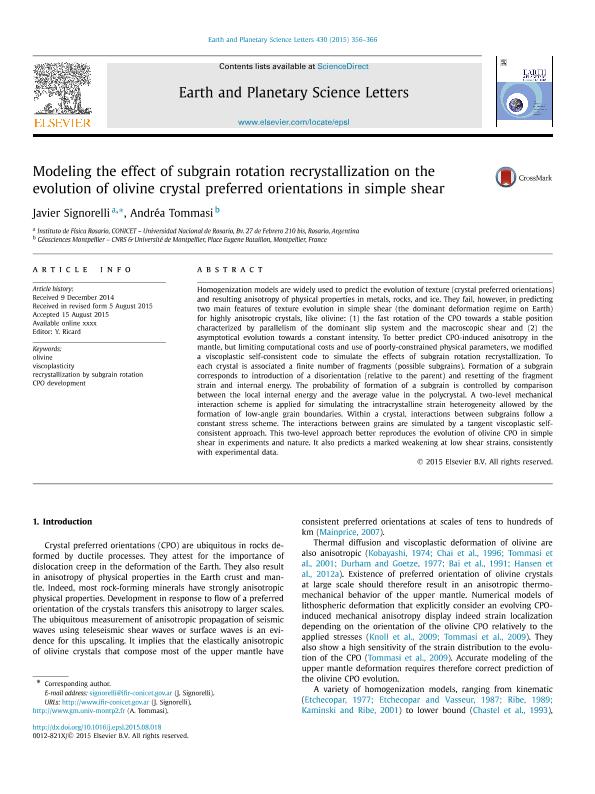Mostrar el registro sencillo del ítem
dc.contributor.author
Signorelli, Javier Walter

dc.contributor.author
Tommasi, Andréa
dc.date.available
2016-06-09T20:45:53Z
dc.date.issued
2015-08
dc.identifier.citation
Signorelli, Javier Walter; Tommasi, Andréa; Modeling the effect of subgrain rotation recrystallization on the evolution of olivine crystal preferred orientations in simple shear; Elsevier; Earth and Planetary Science Letters; 430; 8-2015; 356-366
dc.identifier.issn
0012-821X
dc.identifier.uri
http://hdl.handle.net/11336/6140
dc.description.abstract
Homogenizationmodels are widely used to predict the evolution of texture (crystal preferred orientations) and resulting anisotropy of physical properties in metals, rocks, and ice. They fail, however, in predicting two main features of texture evolution in simple shear (the dominant deformation regime on Earth) for highly anisotropic crystals, like olivine: (1) the fast rotation of the CPO towards a stable position characterized by parallelism of the dominant slip system and the macroscopic shear and (2) the asymptotical evolution towards a constant intensity. To better predict CPO-induced anisotropy in the mantle, but limiting computational costs and use of poorly-constrained physical parameters, we modified a viscoplastic self-consistent code to simulate the effects of subgrain rotation recrystallization. To each crystal is associated a finite number of fragments (possible subgrains). Formation of a subgrain corresponds to introduction of a disorientation (relative to the parent) and resetting of the fragment strain and internal energy. The probability of formation of a subgrain is controlled by comparison between the local internal energy and the average value in the polycrystal. A two-level mechanical interaction scheme is applied for simulating the intracrystalline strain heterogeneity allowed by the formation of low-angle grain boundaries. Within a crystal, interactions between subgrains follow a constant stress scheme. The interactions between grains are simulated by a tangent viscoplastic self-consistent approach. This two-level approach better reproduces the evolution of olivine CPO in simple shear in experiments and nature. It also predicts a marked weakening at low shear strains, consistently with experimental data.
dc.format
application/pdf
dc.language.iso
eng
dc.publisher
Elsevier

dc.rights
info:eu-repo/semantics/openAccess
dc.rights.uri
https://creativecommons.org/licenses/by-nc-nd/2.5/ar/
dc.subject
Olivine
dc.subject
Viscoplasticity
dc.subject
Recrystallization by Subgrain Rotation
dc.subject
Cpo
dc.subject.classification
Geología

dc.subject.classification
Ciencias de la Tierra y relacionadas con el Medio Ambiente

dc.subject.classification
CIENCIAS NATURALES Y EXACTAS

dc.title
Modeling the effect of subgrain rotation recrystallization on the evolution of olivine crystal preferred orientations in simple shear
dc.type
info:eu-repo/semantics/article
dc.type
info:ar-repo/semantics/artículo
dc.type
info:eu-repo/semantics/publishedVersion
dc.date.updated
2016-06-01T13:49:11Z
dc.journal.volume
430
dc.journal.pagination
356-366
dc.journal.pais
Países Bajos

dc.journal.ciudad
Amsterdam
dc.description.fil
Fil: Signorelli, Javier Walter. Consejo Nacional de Investigaciones Científicas y Técnicas. Centro Científico Tecnológico Rosario. Instituto de Física de Rosario (i); Argentina
dc.description.fil
Fil: Tommasi, Andréa. Universite Montpellier Ii; Francia
dc.journal.title
Earth and Planetary Science Letters

dc.relation.alternativeid
info:eu-repo/semantics/altIdentifier/url/http://www.sciencedirect.com/science/article/pii/S0012821X15005385
dc.relation.alternativeid
info:eu-repo/semantics/altIdentifier/doi/10.1016/j.epsl.2015.08.018
dc.relation.alternativeid
info:eu-repo/semantics/altIdentifier/doi/http://dx.doi.org/10.1016/j.epsl.2015.08.018
Archivos asociados
